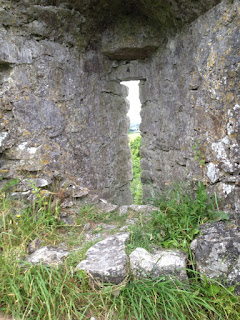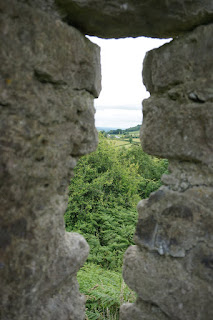We made it! We arrived safely in Dublin and have been going non-stop ever since.
 |
| Our first glimpse of Ireland |
We headed west and spent a little while trying to figure out what the icons on the street signs meant. It's a fun little game and thankfully, not a hard one, for the most part. We found a rest area, picked up a quick bite to eat and continued on our journey. It was awesome to just take in the scenic Irish countryside as we traveled.
About half way to Limerick, we made our first foray onto Irish back roads. A little background - Irish roads are narrow - think of a lane and a half on a US road for an Irish highway and maybe a lane/ruts for many of the country roads (two way traffic, mind you!). There is little to no shoulder and there are old stone walls covered in brush and greenery on both sides of the road. So we set off and were pleasantly surprised that the road wasn't too bad!
We had to pull off to the side a bit to let a large tractor pass and were able to squeeze past a few other cars on the road. We had downloaded the Google map of Ireland and are happy to report that it was very accurate and more precise than most GPS in Ireland, apparently. We headed up the hill and around the corner. Our first view of the Rock of Dunamase was awesome and we were the only ones there!
We parked and spent a few minutes looking at the Holy Trinity Church, located at the foot of the Rock. It was built in 1861 and is still a place of worship. The church has a bell and just below the bell tower was a large nest. We'd hoped to see the bird that lived there, but it didn't show itself during our visit, leaving us to imagine a gigantic fowl of some sort.
We turned around and began our exploration of the Rock of Dunamase. The site is a National Historic Site. The history I am about to give you is taken word for word from the sign at the entrance to the site.
"Dunamase Castle was founded in the late 12th century on the site of a 9th century dun or fort. It passed into Anglo-Norman possession on the marriage of Aoife, daughter of Dermot MacMurrough, to Strongbow. Their daughter Isabel married William Marshal, Earl of Pembroke and the Marshal family held Dunamase until the mid-13th century. It was the center of military and administrative power in this part of Leinster under Marshal. It then passed through marriage to the Mortimers who held it into the mid-14th century."
"Records indicate that it changed hands several times after Roger Mortimer was executed for treason by order of Edward III. It possibly ended in possession of the Irish O'Mores, who are credited with its destruction. It fell into disuse shortly thereafter. The castle is said to have been rendered harmless during the Cromwellian period. The hall was partially restored as a residence at the end of the 18th century, by Sir John Parnell, speaker of the Irish Parliament and grandfather of Charles Stewart Parnell. After his death, his son let it fall into its final decay."
"The castle is approached through an outer barbican."
"The arched outer gate leads into the inner triangular barbican, whose outer walls have plunging arrow loops in embrasures, under the wall walk."
"Above this are the main gatehouse and the curtain wall which surrounds the crow of the hill."
"The curtain wall incorporates an earlier gatetower and a postern gate on the western side."
 |
| Looking down on the curtain wall and gate house |
"The gatehouse provided a high level of defense, with a portcullis protected by inward facing loops from the side chambers and probably by a murder hold above, and a gate, set just over half way up the passage. The front of the gateway has the remains of a two slot counter-weight drawbridge."
"On top of the hill stands a massive rectangular hall, with a two storey solar."
It is thought to be of late 12th century date, with a batter added to the base in the early 13th century. The work, attributed to Parnell, includes the re-build of the north west corner and insertion of medieval features from other sites. These include a medieval doorway and a window with hood-moulding."
I can't even begin to explain how thrilling it was to be the only people there, free to explore, climb, sit, and take in the atmosphere of these historic ruins. I could hear the whispers of generations past echoing through the air... or maybe it was the low pitched lowing of cattle in the nearby fields.
Just as we were leaving, two cars of people arrived and a misty rain began to fall. Perfect timing! We continued our drive to Limerick, passing the Barack Obama Plaza on our way. We didn't stop, but you can read about the exhibits about American Presidents with Irish heritage located inside this Moneygall rest stop here.
Shortly after passing through a tunnel under the Shannon River, we hit the outskirts of Limerick. Multiple round-abouts later, we arrived at our hotel, the Radisson Blu Limerick and ate a quick lunch in the restaurant there as our room wasn't quite ready yet. After our lunch, we were able to check in. Our room is the only family room at the hotel/spa which could accommodate 5 people. It is quite large, even by American standards.
There are three twin beds and a queen. Plenty of space to move around, a desk, a table, a dvd player, in-room safe, fridge, arm chair... it seems like a comfortable place.
After a few minutes of rest, we decided we needed to adapt to the local time as much as possible to avoid jet lag, so we hopped back in the car and drove into Limerick to visit King John's Castle.
Upon arrival, we entered an interactive museum explaining about early Gaelic society, the Normans in Limerick, the change and conflicts that came about during the reformation, and the sieges of 1642, 1651, and 1690/91.
During the sieges, both armies would dig tunnels - one to try to get into the keep, and the other to try to get supplies and have an escape route.
The kids got to build a castle wall, fire cannons, crawl through a siege tunnel, see artifacts, see/hear about the various jobs within the keep, and get a general feel for the history of the area. Then we entered the undercroft, where they are still excavating parts of the castle walls.
Leaving the undercroft, we found ourselves in the main courtyard of the castle.
 |
| The Great Hall. On the left lower level, you can just make out a doorway. That was the door to the outhouse, which hung out over the River Shannon for easy clean-up. |
 |
We explored the castle, touring the turrets, the mint, the mason shop, and the gatehouse.
In the courtyard, there were swordsmen, minstrels, a blacksmith, and other reenactors ready to make history come alive. The younger two really enjoyed learning about the different swords that were used!
While the younger girls used the restroom, the eldest and I went for a walk to check out nearby St. Mary's Cathedral.
It was a nice little walk and we enjoyed soaking in more Irish history on our first day here.
Meeting back up with the rest of the family, we drove around to the other side of the river so I could get a picture of the entire King John's Castle.
We are exhausted and grabbed a quick bite to eat back at the hotel. Now we are getting ready for a good night rest before our adventures continue!









































Post a Comment
Love to hear from you!